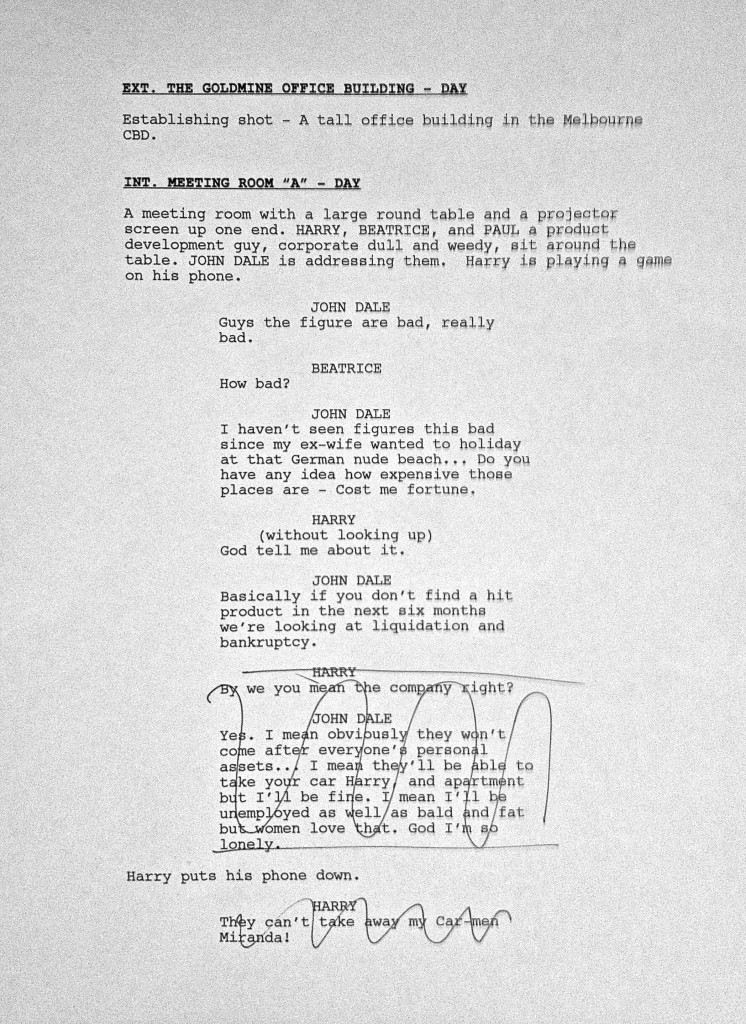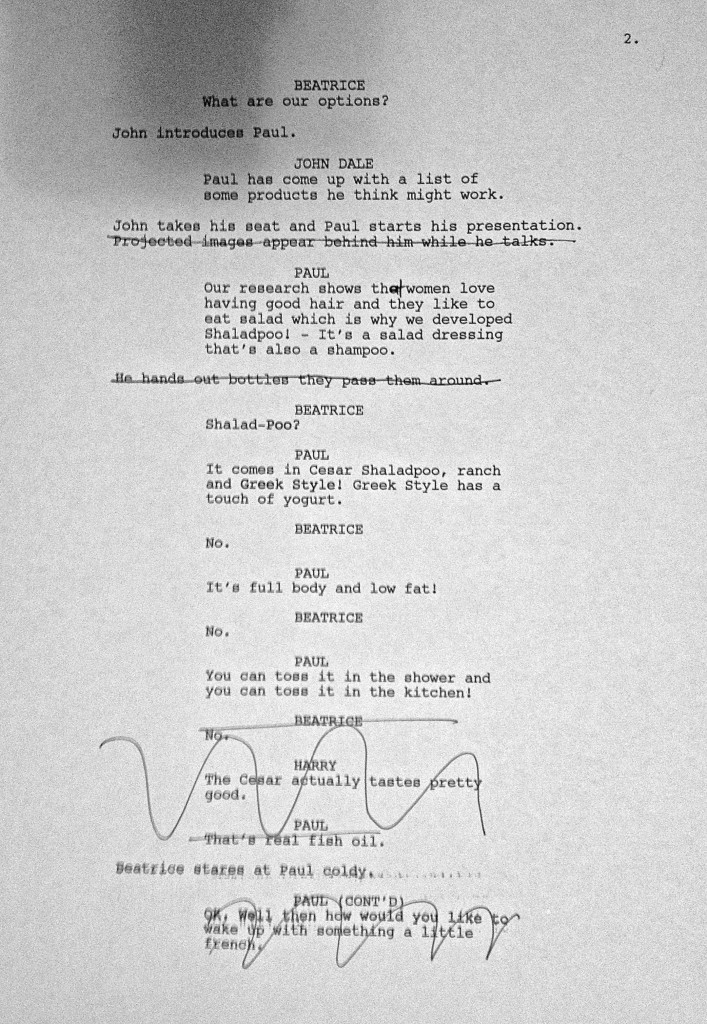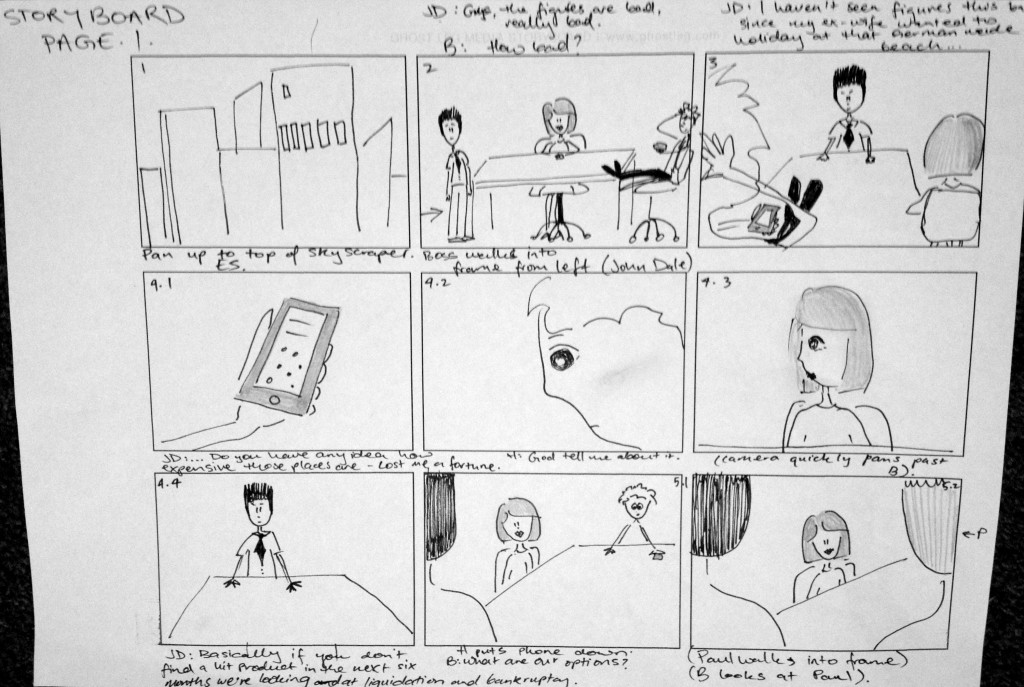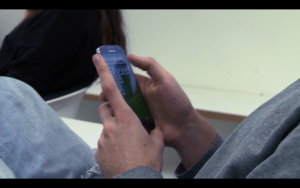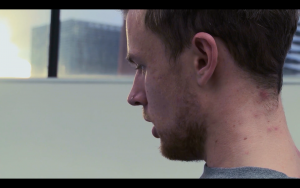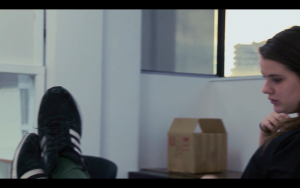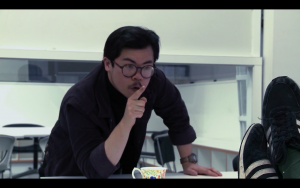Script by David Dreimann (edited by me):
For Week 10s shoot I decided to employ Alfred Hitchcock’s method of filmmaking. Thus, I underwent an intensive pre-production process, where I storyboarded every shot and every camera and character position for my scene. (I decided not to include lighting specifications in the storyboards because I was mainly focussing on camera coverage for this shooting exercise). I chose a script that would be easy to shoot in class because it had a ‘boardroom’ setting that could be constructed using an RMIT classroom, table and chairs. I printed out edited down versions of the script for the cast and a shot list examining framing, character actions, dialogue and camera movement for my DOP to work off. During the shoot, I found that the storyboards were actually a more efficient way of explaining what I wanted to the DOP in comparison to the shot list. The shot list helped me to get my head around the scene, but it was not much use during the actual shoot; the storyboards were much more visual and gave an exact representation of the framing that I wanted.
STORYBOARD ROUGH DRAFT
STORYBOARD FINAL
I decided to shoot my scene during class time, because I needed (at least) three actors and a DOP. Ultimately I would have liked a sound operator as well, but there wasn’t enough people in our group, so we ended up just plugging the microphone straight into the Sony EX3 camera and I held the boom, which I don’t think impeded on my ability to direct at all. On the whole, the shoot went rather smoothly. There were a few lighting problems because the room we were shooting in was west-facing and it was late afternoon, so at times the sun was shining directly into the camera and by the end of the shoot (and the scene, because we were shooting chronologically) the room had become quite dark. This was a slight problem during the editing process; we weren’t refreshing our white balance throughout the shoot and so the colour of the light changed quite a lot from the beginning to the end of the scene. This made it difficult to keep the colour tone, brightness and contrast consistent throughout all the shots when I was grading.
One of the requirements of this shoot was letting someone else be in control of the camera. This was difficult for me and I found myself wondering how Hitchcock ever shot a film without looking through the viewfinder of a camera. I definitely don’t think I have Hitchcock’s instinctive talents or his level of trust for camera operators. Nevertheless, having a DOP made things relatively stress-free for me as a director. I was able to concentrate solely on coordinating the shoot and trying to get it all done efficiently (acting as my own first AD). Although directing is quite an odd concept when you take away the fact that I wasn’t in control of the camera at all and the actors pretty much had free reign over how they wanted to play their characters (aside from abiding by the script), I still felt like I had plenty to do. Mostly I was just talking to the camera operator and the actors – explaining how I wanted the scene to look, sound and feel. Although I really liked the process of filming when I didn’t have to worry about the technical aspects of the shoot, I don’t think it created the best possible results. The problem I had with it was that even though I was trying my hardest to communicate to the DOP exactly what I wanted, no one would have ever been able to completely grasp the idea I was picturing in my head. I don’t think that this was the only reason the scene didn’t turn out exactly how I had wanted it to, but in the future I have decided that I would rather control the camera on my own shoots. This way I will be able to keep tabs on the framing and exposure throughout the whole process and watch each shot as it is being recorded so I know if I need to do another take. Instead of a DOP, I think I need a first assistant director. If I had a first AD I would be able to pay close attention to the camera work and not have the added pressure of making sure the shoot runs smoothly. I think it would also be helpful to have a second set of eyes on set (that aren’t an actors), helping to point out discontinuities in character movements and lighting. As much as I would love to be a one man band, I think a shoot runs much more smoothly and the end product is much more polished, when I have people helping me behind the scenes.
In looking at this finished sequence as a whole, it doesn’t feel like a unified, cohesive piece of work. Ultimately, I put this problem down to the fact that I ‘crossed the line’ mid way through the scene. As I was storyboarding I was aware that I was going to break the 180 rule, however, when I looked at it on paper it didn’t look like it would be much of a problem. I had already crossed the line in a couple of shoots during the semester and I had been watching a few films that had completely disregarded the rule, so I thought, why not break it myself? I really wanted to create a dynamic composition, by having each character on separate visual planes; and crossing the line just happened to be the only way I could think of achieving this. Unfortunately my rebellion against traditional Hollywood continuity filmmaking backfired on me and I ended up with a selection of shots that felt completely disconnected from one another. I probably could have gotten away with putting shot 1 and 2 next to each other, however, when you chuck shot 3 into the mix (crossing the line for a second time), it becomes all too confusing to watch. Particularly because shot 3 begins as a closeup of the phone, the audience is not able to gauge a great sense of space and so it almost appears as if the character holding the phone has magically switched the way he is facing between shots.
Other than the continuity problems, the camera coverage of the scene is okay. My favourite shot is shot 3 that tilts up from a high angle of the phone to a closeup of Tom and then pans around past Maddie to a mid-shot of Michael. Nevertheless, the shot was not perfect. I think the pan could have been a bit faster in order to quicken the pace and dramatise the scene a bit more and it also would have been nice to have Maddie in focus along the way. Aside from this shot, the camera coverage for the scene was pretty mainstream. Essentially it just begins with an establishing long shot of all the characters and then there is a couple of over the shoulder shots. Partly I think this conventionality stemmed from the script which did not leave much room for creative camera work (because all the characters were relatively stationary throughout the scene). For my final shoot I think it would be worth reading through a few more scripts/proses and considering ones I have worked off in the past to make sure I find a scene that will enable dynamic camera coverage. In saying this, I also think part of the reason the scene does not look altogether interesting is because of the method I used to shoot the film. Having everything prepared on the day did not give me any room to be spontaneous, as I was solely concentrated on getting through the shots I already had planned out in front of me. Although Hitchcock believes that there is plenty of time to be spontaneous before you actually shoot a scene, sitting at a desk and writing/drawing out shots is very different to physically walking around with a camera in the real shooting location. Personally, I seem to create more interesting pieces of work when I am able to employ a more ‘hands-on’ approach to shooting. I like to be looking through the camera on set and have the option to try out a number of different shots before shooting the scene. However, this does not mean that I couldn’t storyboard as well as improvise some of my camera work. At this point I am just trying to figure out how much of the scene I would need to storyboard and at which point in the filmmaking process this needs to happen.
Similarly to the Woody Allen shoot I struggled with editing this scene because I had shot it without doing any ‘coverage’ (i.e. I had only filmed each shot from a single perspective). I thought that because I had preplanned the shoot in advance, I would be able to get away with essentially editing in camera. However, this wasn’t the case. I don’t think that an entire scene worth of shots needs to be filmed from every different perspective possible, but it would be beneficial to have some alternative options in the editing room. Often my original shots do not work out as well as I had envisioned them, so it would nice to be able to have another perspective to work with. For example, it would have been great to have filmed ‘shot 2’ of this scene from a couple of different perspectives (where I didn’t cross the line), to see if this would have helped to unify the scene in any way. This concept of shooting ‘more’ coverage of a scene does not necessarily mean that I would shoot the ‘hell’ out of it (filming the entire scene from several different perspectives). Instead, I would shoot one or two extra shots from alternative perspectives, just so I have the option of including them when I start to edit. These ‘extra’ shots need not be planned out, they might just be improvised test shots, but at least this would offer me the opportunity to be a bit spontaneous on set and provide me with ‘backup’ shots if my original plans fail.
In conclusion, Hitchcock’s method of filmmaking had its advantages and disadvantages for me. I think having clear storyboards on set is beneficial because it was the best way that I could explain what I wanted from my cast and crew in a polite and efficient manner. Drawing my scenes before shooting is definitely going to be something I continue with, however, my plans might not be as definitive as Hitchcock’s were. From here on in, I think I would rather take control of the camera and have a first AD help me run the shoot. Over the last couple of shoots, particularly this one and the Woody Allen one, I have realised that a better edit is achieved when there are more options (in terms of shots) to chose from. Thus I think it would be advantageous to have multiple takes and shoot at least one alternative perspective of each shot. Overall, this process of shooting was about as far away from improvisation as you can get and I think this was one of the reasons the end product was relatively boring to watch. Ultimately, a bit of spontaneity helps to spice things up a bit. I didn’t find that I was getting excited on set watching any of the shots for this scene, like I had been when I used Nicholas Winding Refn’s method. Paul has said that every cut in a scene should make you cry because it’s so beautiful. I think this is the same with framing, performance, lighting or any other filmic element. Ultimately I want every creative decision that I make to evoke a positive emotional response, even if I’m the only one that feels it. I think this is what makes the filmmaking process so much fun and so satisfying.
